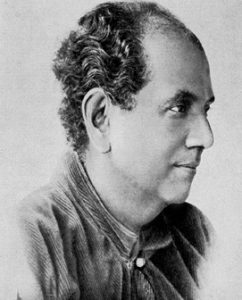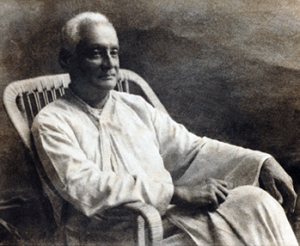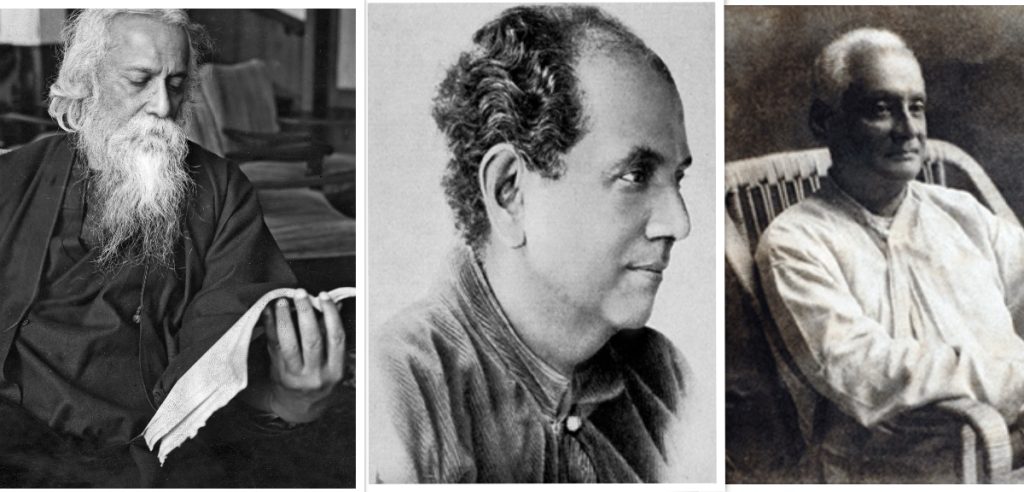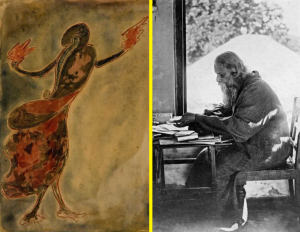Pratiksha Shome
The Thakurs of Jorasako have been one of the most influential and celebrated families across Bengal. They made their way to social eminence in the eighteenth century first as employees to the European traders in Bengal and then in the early nineteenth century as business entrepreneurs, landholders, religious leaders, administrators, litterateurs, legal practitioners, and social activists, which course is another story to tell. Their contribution to shaping the culture of Bengal remains intangible. A large portion of intellectual literate belongs to this family inducing themselves into different forms of artistry. So, it is no surprise that the most prized artists of Bengal belonged to this family contributing to the art movement and intermixing different styles of art to create their own.
Although there have been many artists within the large branch of this family, including Tagore’s brother Jatindranath, the contributions of Rabindranath, Abanindranath, Gaganendranath and Sunayani Devi helped change the social structure of Bengal. Abanindranath, Gaganendranath and Sunayani Devi (All of them being siblings)are nephews and niece to Rabindranath Tagore from his extended family and were extremely close to him and catered to his ideologies.
Rabindranath:
Rabindranath Tagore, widely acclaimed as the Bard of Bengal, was a literary genius and a remarkable artist. While he is primarily known for his contributions to literature, Tagore’s paintings are a testament to his multifaceted talent and artistic vision. Tagore’s artistic journey began in the late 19th century, influenced by the Renaissance and Post-Impressionist movements. He was 65 when he started painting and one of the main reasons for such interest is curating money for the newly formed institute he called “Visva Bharati”. His early works were characterized by their realistic yet mystic representations of nature and human figures. However, as he matured as an artist, Tagore developed a distinct style that transcended traditional boundaries and merged different artistic elements.
One of the most striking aspects of Tagore’s paintings is the fusion of colours and forms that create a sense of harmony and rhythm. His brushstrokes were bold and expressive, infusing life into his subjects. Whether depicting landscapes, portraits, or still life, Tagore’s use of vibrant colours and imaginative compositions evoked a sense of emotion and spirituality. His paintings often reflected his deep connection with nature and his inner world, capturing the essence of his poetic soul. Most of his paintings, especially human faces however are depicted as sorrowful people most probably indicating his state of mind when he lost almost all his family members and close acquaintance with time.
Tagore’s artistic endeavours were also deeply rooted in his cultural heritage and his perspective as a Bengali. His paintings often featured scenes from rural Bengal, capturing the rustic charm of village life. The simplicity and authenticity conveyed through his art resonated with the common people, who found solace and beauty in the familiar settings he depicted.
Moreover, Tagore’s paintings were not limited to traditional art forms. He experimented with various techniques, including wash and tempera painting, and incorporated elements of Japanese art, Chinese calligraphy, and Persian miniatures into his works. This amalgamation of diverse influences gave his paintings a unique character and a global appeal. Tagore’s art transcended cultural boundaries, serving as a bridge between Eastern and Western artistic traditions.
Beyond their aesthetic value, Tagore’s paintings also conveyed profound philosophical and spiritual messages. His art was often imbued with themes of humanism, love, and the search for inner truth. Through his paintings, he explored the intricacies of human emotions and the interconnectedness of all life forms. Tagore believed art had the power to uplift and inspire, and his paintings embodied this belief by evoking a sense of wonder and transcendence.
To know more about Tagore’s Art Click here
Also read: Click here
Abanindranath:
Born on August 7, 1871, in Kolkata, India, Abanindranath Tagore, aka Aban Thakur, was not only a painter but also a poet, philosopher, and educator. His artistic style and vision played a crucial role in shaping the Indian art scene in the early 20th century.
Needless to say, the artistic ability of Abanindranath Tagore is well-known to the Western world, surprisingly much more profound than his uncle Rabindranath at that time. In fact, Abanindranath as an artist gathered more recognition in the then-western society than any other Indian artist of that time. He was more lenient towards traditional Indian art forms than European influence on Indian art, starting a movement with “Swadeshi” influence calling it the “Bengal School of Art”. Although in 1986, his friend the then principal of Government College of Art and Craft, Calcutta, E.B. Havell, supported the cause and helped him lead the movement and led to develop modern art. It should be mentioned that Mughal art was also one of the influences on Abanindranath that lead him to support Indianization/nationalism in art.
One of the influences of Abanindranath as an artist came from his childhood. He spent a fair share of his childhood at the garden house of Champdani situated near the river Ganges. The atmosphere here was quite different from that of Calcutta. It was an old rambling house reputed to be haunted and standing on extensive grounds which were originally inhabited by robbers and men of ill fame and stood close to the French territory of Chandernagore. The park attached to the house spread over nearly 100 bighas of land and was strewn with bones and skulls. This haunted house served to stimulate the boy Abanindranath’s artistic faculties. In the park there were peacocks, cranes and many other kinds of birds; and deer and other animals freely roamed about in it. In the morning the grounds remained strewn with the feathers of various kinds of rare and beautiful ducks which had been devoured at night by jackals. The house itself was like a museum stored with artistic vases, carpets, screens and other antique furniture, of diverse colours and designs which left a deep impression on the mind of the young artist. Abanindranath used to make free use of his father’s pencils and brushes as we have already seen, and here the animals and birds served as living models, while the vases and carpets offered him many kinds of designs and colour combinations.
One of Tagore’s most notable contributions was the creation of the “Indian Society of Oriental Art” in 1907. This society aimed to promote and preserve traditional Indian art forms, encouraging artists to explore indigenous techniques and themes. Through this initiative, Tagore not only inspired a new generation of artists but also challenged the dominance of Western artistic styles in India.
Tagore’s artistic style was characterized by a unique blend of traditional Indian techniques and modern influences. He skillfully incorporated elements from Mughal and Rajput miniature paintings, creating a harmonious fusion of form and content. His use of vibrant colours, intricate detailing, and delicate brushwork added depth and richness to his artworks.
The art of Abanindranath Tagore holds immense cultural and historical significance. It represents a powerful expression of Indian identity and a desire to preserve and celebrate indigenous traditions. His legacy continues to inspire artists to this day, reminding them of the importance of embracing their cultural heritage while exploring new artistic possibilities.
Abanindranath Tagore’s art remains an essential pillar of Indian art history. His vision, commitment to tradition, and innovative approach have left an indelible mark on the artistic landscape.




Courtesy: Wikipedia
Gaganendranath:
Gaganendranath Tagore, a pioneer of modern Indian art, made significant contributions to the art world during the early 20th century. Born on September 18, 1867, in Kolkata, India, Gaganendranath Tagore was a multifaceted artist known for his paintings, caricatures, and illustrations. His art reflected a unique blend of modernity and traditional Indian aesthetics, making him a pivotal figure in the evolution of Indian art.
Gaganendranath Tagore’s artistic style was characterized by experimentation and innovation. He was one of the first Indian artists to incorporate elements of Western modernism into his work. Inspired by the works of European masters, such as Paul Cézanne and Pablo Picasso, Gaganendranath explored new techniques and perspectives in his paintings. His use of bold colours, geometric forms, and abstract figures challenged traditional artistic conventions and pushed the boundaries of artistic expression in India.
One of Gaganendranath’s most notable contributions was his creation of the “Indian Society of Oriental Art” alongside his younger brother Abanindranath Tagore. This society aimed to promote a synthesis of Eastern and Western artistic traditions, encouraging artists to experiment with various styles and techniques. Gaganendranath’s artistic vision played a significant role in shaping the Bengal School of Art and its philosophy of embracing both tradition and modernity.
Gaganendranath’s talent was not limited to painting alone. He was also a skilled caricaturist and illustrator, and later in his career, he used art to satirize social and political issues of his time. His caricatures were sharp and witty, offering insightful commentary on the society and its cultural dynamics.
The art of Gaganendranath Tagore continues to inspire and captivate art enthusiasts today. His willingness to challenge artistic norms and his innovative approach to merging Eastern and Western influences make him a trailblazer in the Indian art scene. His legacy reminds us of the importance of artistic exploration and the power of art to transcend boundaries.











